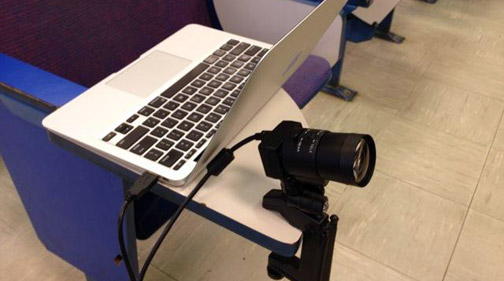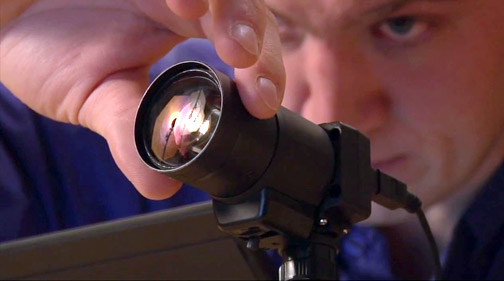Enabling Students with Limited Vision to Take Notes in Class
In the United States alone, there are over 20 million individuals with limited vision. Of these, at least 3 million are legally blind. Counted among these statistics is a young man named David Hayden. David can read materials if they are very close, but he cannot view distant presentations. Also, his condition cannot be corrected with surgery or prescription. Yet, he is currently pursuing a PhD in Computer Science at the world renowned Massachusetts Institute of Technology (MIT). How does he do this with limited vision? By using a system that combines optical and digital zoom with high-definition video to empower low-vision individuals to view classroom and business presentations, and take their own notes directly on their laptop.
Watch the Note-Taker Video
See How the Note-Taker Began
When initially searching for assistive technology, David found board magnifiers to be bulky, expensive, and of such poor visual quality that a single university-sized chalkboard could not be viewed continuously panning the camera. Most also required special carrying cases that do not fit on the small desks typical to classroom environments. Being bulky has another and more important disadvantage: they draw unwanted attention to the user, making them stand out. After a fruitless search, David decided to build his own.
The Note-Taker
The result is the Note-Taker, a portable, lightweight, and discreet system that includes hardware for streaming live video and software in which users take notes while simultaneously viewing a distant presentation.
Choosing the right camera
David's camera requirements were clear:
- Small and light to ensure the overall system is discreet and easily portable
- Rugged so that students can just throw the system into their backpacks with no special casings
- USB 2.0 support for ease of use, for power (minimize complexity) and cross-platform capabilities.
- 23 FPS to ensure a smooth video so users can focus on the lecture without being distracted by choppy video.
- Colour resolution higher than standard projectors which are 800x600
- Low-cost so that families can either afford the system on their own or apply for funding through state-based vocational rehabilitation agencies.
- A camera that works day-in, day-out for years as users go through their academic and business careers.
David chose FLIR's FireFly MV 1.3 megapixel USB 2.0 camera which measures just 24.4 x 44 x 34 mm and weighs just 37 grams (including the tripod adapter). This model has a resolution of 1328x1048 and runs 23FPS to provide clear images of even the finest details on a chalk board.

System Design
The system comes with a FireFly MV camera and varifocal lens capable of resolving materials in classroom or business presentation from distances that, in practice, rarely exceed 5 – 40 feet The camera and lens are attached to a foldable tripod which can also clamp onto a desk. The entire hardware portion is no heavier than a can of soda and barely taller.
Users set up the camera, attach a cable to their laptop and fire up the Note-Taker software. The GUI provides a split-screen interface where users simultaneously view the live stream as well as their own notes being taken. Users manually adjust focus and optical zoom once, at the beginning of class, and subsequently are able to use multi-touch gestures to quickly pan and zoom the image and their notes. Using the laptop's built-in microphone, users are able record audio which is synchronized with screenshots and notes for later review.
The Note-Taker is so-named because it replaces what low-vision students would normally use in classroom settings—a human note-taker, the availability of which is mandated by the Americans with Disabilities Act. David notes that, "reading another's notes is as foreign as a textbook, only less legible." And the research clearly agrees: students who take their own notes perform better on tests, even if they never subsequently review them. By making the Note-Taker portable, discreet and affordable, David hopes that the Note-Taker will improve job prospects for the more than 60% of legally blind individuals who are not employed.
What's next?
The Note-Taker is currently in final beta testing with a number of students ranging in age from 7 – 52. The units are available for sale in limited quantities. Once these trials are concluded, David will more aggressively promote the Note-Taker, including establishing distribution with standard assistive technology suppliers and funding agencies.
